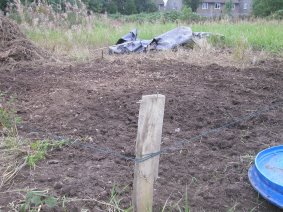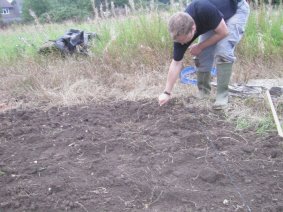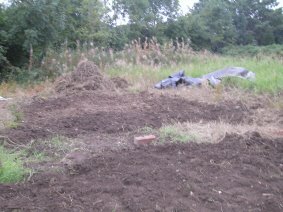sowing the seed
 Apologies anyone who is excitedly waiting for news of our allotment. Life took over for a few days and I was having a problem with updating the blog.
Apologies anyone who is excitedly waiting for news of our allotment. Life took over for a few days and I was having a problem with updating the blog.Anyway. Having cleared around half of the length of our allotment plot, we have been going back to start thinking about what to do with it. In this photo you can see in the far top left corner the big pile of soil and roots from the weeds (not really even compostable, just rubbish). Closest to the camera is a stake which we used to mark out the plot.
This bed, number 1, is actually our green compost plot. Green manuring is a technique you can use if you don't have a lot of compost, and basically what happens is that you plant a crop over the winter with the idea that it grows and you dig it in before sowing vegetables in the spring. As the green manure decomposes the growing plant can use nutrients released. Here is a more detailed explanation from our friends at HDRA. We have planted a variety of Rye intercropped with a Field Bean. Since we took this photo, we've had heavy rain which has caused the string to snap.
 Here I am planting seed. This is a photo taken by Bethany. Quite lovely as I'm sure you'll agree, well done Bethany.
Here I am planting seed. This is a photo taken by Bethany. Quite lovely as I'm sure you'll agree, well done Bethany.I am trying not to stand on the beds where we've sown the seed, but this is going to be difficult as the weeds start to come back. Hopefully the seedlings will come up in straight lines so we know where they are. Oh look, there's a flying pig.
A couple of other things, the tool to my right in this photo is a type of mattock called an Azadas
which is the kind of thing you see people in Africa using to bash the soil. Behind me is a bit of old plastic we found hanging about in the allotments (not on anyone else's plot I'll quickly say) which we are now using as a mulch to stop the weeds coming up in a bed we've yet to decide what to do with.

This is a photo overlooking our second bed, the first bed and the pile of rubbish (stop me if this is getting boring..). We planted Rocket in this bed, which is a type of winter salad. Not really my choice, but a free sample we received with the magazine Kitchen Garden which is quite an interesting read if you are into that kind of thing.

0 Comments:
Post a Comment
<< Home